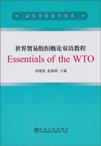世界贸易组织概论双语教程
2010-8
张晓青、 赵振铎 冶金工业出版社 (2010-08出版)
张晓青,赵振铎 编
117
2001年8月,教育部在《关于加强高等学校本科教学工作提高教学质量的若干意见》中提出:“为适应经济全球化和科技革命的挑战,本科教育要创造条件使用英语等外语进行公共课和专业课教学。对高新技术领域的生物技术、信息技术等专业,以及为适应我国加入WT0后需要的金融、法律等专业,更要先行一步,力争三年内外语教学课程达到所开课程的5%~10%。”在此后的几年中,许多高校在不同的学科领域都开设了双语教学课程。由于国外的教学体制和课程设置与我国的教学体制和课程设置存在一定的差异,我国有些课程几乎没有原版的英文教材可以使用。“世界贸易组织概论”就属于其中的一门课程。我们从2004年至今,一直对该门课实施双语教学,苦于没有原版英文教材,就直接从世贸组织的网站上下载“Understanding the WTO”自编成讲义以供教学使用,让学生了解到了原汁原味的世贸组织基本知识。但不足的是“Understanding the WTO”在内容编排和结构上离我们教学的要求还有一段距离。为了解决“世界贸易组织概论”这门课的双语教材问题,我们总结以往教学的一些体会,对原先使用的讲义,在内容的编排和结构上做了调整和修改,并充实了相关内容,形成今天的这本《Essentials of the WT0》,供双语教学使用。该教材的特点是每章开篇对整章内容有中文提示,文中有小标题提示内容的中心思想,章后附有注释对难点和重点进行解释,这样,既适合中国老师的教学习惯,又能满足学生的阅读习惯,有利于双语教学的顺利开展和教学质量的提高。由于编者的学识有限,书中难免有不足之处,请读者不吝指教。
《世界贸易组织概论双语教程》分5章介绍世界贸易组织(WTO)的产生及运行机制、WTO的基本原则、WTO的有关协议、WTO贸易政策审议机制和争端解决机制、发展中国家在世贸组织中的状况,书后附有WTO成员国名单、WTO的缩略语和术语。《世界贸易组织概论双语教程》内容适合48学时的授课,可作为经贸专业的本科生、研究生的教材使用,也可供经济界学者参考阅读。
Chapter 1 The Establishment and Operating System of the WTO1.1 The Establishment of the WTO1.1.1 The GAIT years: from Havana to Marrakesh1.1.2 The Uruguay Round1.1.3 The post-Uruguay Round built-in agenda1.2 The Status, Purpose, Objectives and Functions of the WTO1.2.1 Status of the WTO1.2.2 The purpose of the WTO1.2.3 The objectives of the WTO1.2.4 The functions of the WTO1.2.5 Differences between GATT and WTO1.3 Scope of the WTO1.4 Structure of the WTO1.4. l The Ministerial Conference1.4. 2 The General Council in three guises1.4. 3 Councils for each bread area of trade, and more1.4. 4 Committees1.4.5 Plurilateral Committee1.4.6 The Secretariat and director-guneral1.5 Decision-making of the WTO1.5. 1 Decisions taken by consensus1.5.2 Levels of authority1.6 Membership of the WTO1.6.1 Original membership1.6.2 Accession to the WTO1.6.3 How to join the WTO : the accession process1.6.4 Withdrawal from the WTO1.7 Relationship with Other Main Organizations and Regionalism1.7.1 Summary on other organizations1.7.2 Relationship with regionalismQuestionsNotesChapter 2 Principles of the WTO2.1 Trade without Discrimination2.1.1 Most- favoured- nation (MFN)2.1.2 National treatment : treating foreigners and locals equally2.2 Freer Trade: Gradually, through Negotiation2.2.1 Trade barriers2.2.2 The result of negotiations2.3 Predictability: through Binding and Transparency2.3.1 Purpose of predictability2.3.2 Predictability through binding2.3.3 Predictability through transparency2.4 Promoting Fair Competition2.5 Encouraging Development and Economic Reform2.5.1 Contribution to developing countries in the WTO2.5.2 Commitment fulfilled by developing countries2.5.3 Measures to encourage development and economic reformQuestionsNotesChapter 3 The Agreements of the WTO3. 1 Agreements for Trade in Goods3.1.1 Tariffs: more bindings and closer to zero3.1 2 Agriculture : fairer markets for farmers3.1.3 Standards and safety3.1 4 Textiles : back in the mainstream3.15 Anti-dumping, subsidies, safeguards : contingencies, etc3.1.6 Non-tariff barriers : red tape, etc3.1.7 Plurilaterals : of minority interest3.2 Agreement for Trade in Service3.2.1 The background for GATS3.2.2 Main content of GAPS3.2.3 General obligations and disciplines3.2.4 The annexes : services are not all the same3.3 Agreement for Trade-related Aspects of Intellectual Property Rights3.3.1 Scope of intellectual property3.3.2 International protection of intellectual property and TRIPS3.3.3 Summary on TRIPSQuestionsNotesChapter 4 The Policy Review and Settling Dispute4.1 Trade Policy Review4. 1.1 Ways to keep trade policies transparent4.1.2 Trade Policy Review Body4.2 Settling Dispute4.2.1 Summary on dispute settlement mechanism4.2.2 Scope of jurisdiction of DSM4.2.3 WTO bodies involved in the dispute settlement processQuestionsNotesChapter 5 Developing Countries5.1 Overview5.l.1 In the agreements : more time, better terms5.I.2 Legal assistance : a secretariat service5.1.3 Least-developed countries: special focus5.1.4 A "maison" in Geneva: being present is important, but not easy for all5.2 Committees5.2.1 Trade and Development Committee5.2.2 Subcommittee on Least-Developed Countries5.2.3 The Doha agenda committees5.3 WTO Technical Cooperation5.3.1 Mission, objective and subjects5.3.2 Training, seminars and workshops5.4 Some Issues Raised5.4. 1 Participation in the system : opportunities and concerns5.4.2 Erosion of preferences5.4.3 The ability to adapt : the supply-sideQuestionsNotesReferencesAppendixAppendix 1 Current WTO MembersAppendix 2 AbbreviationsAppendix 3 GlossaryAppendix 4 Reading Materials
插图:This first round of negotiations resulted in 45,000 tariff concessions affecting $ 10 billion of trade, about one fifth of the world's total. The 23 also agreed that they should accept some of the trade rules of the draft ITO Charter. This, they believed, should be done swiftly and "provisionally" in order to protect the value of the tariff concessions they had negotiated. The combined package of trade rules and tariff concessions became known as the General Agreement on Tariffs and Trade. It entered into force in January 1948, while the ITO Charter was still being negotiated. The 23 became founding GATT members (officially, "contracting parties ").ITO aborted and GATT became provisionalAlthough the ITO Charter was finally agreed at a UN Conference on Trade and Employment in Havana in March 1948, ratification in some national legislatures proved impossible. The most serious opposition was in the US Congress, even though the US government had been one of the driving forces. In 1950, the United States government announced that it would not seek congressional ratification of the Havana Charter, and the/TO was effectively dead. Even though it was provisional, the GATT remained the only multilateral instrument governing international trade from 1948 until the WTO was established in 1995.
《世界贸易组织概论双语教程》:高等学校教学用书

挺薄的,是英文的教材。
很薄的一本书,并不是完全双语对译的那种,而是关键词句在文章结尾有注释。难度适中,经过了剪辑整编,比直接的外文书更和中国人的胃口。